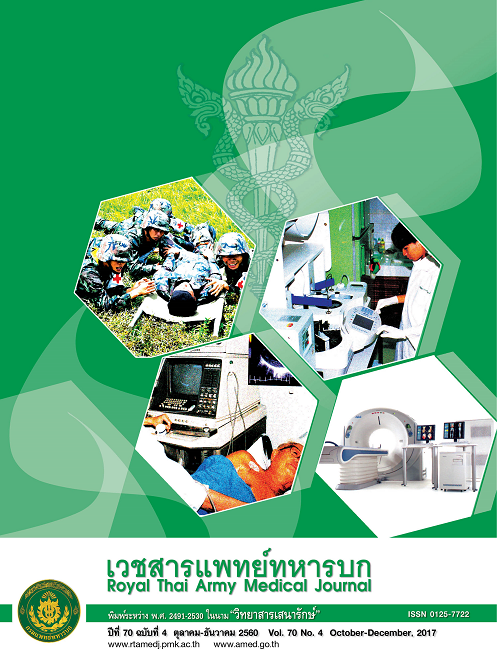ผลการให้บริบาลทางเภสัชกรรมสำหรับผู้ป่วยที่ได้รับยาวอร์ฟารินครั้งแรก ในหอผู้ป่วยอายุรกรรมและศัลยกรรม ณ โรงพยาบาลพระมงกุฎเกล้า
Main Article Content
บทคัดย่อ
วัตถุประสงค์ เพื่อศึกษาผลการให้บริบาลทางเภสัชกรรมโดยเภสัชกรสำหรับผู้ป่วยที่เริ่มการรักษาด้วยยา warfarin เป็นครั้งแรกต่อร้อยละของค่า international normalized ration (INR) ที่อยู่ใน therapeutic range ในหอผู้ป่วยอายุรกรรมและหอผู้ป่วยศัลยกรรมโรงพยาบาลพระมงกุฎเกล้า ช่วงเดือนกรกฎาคม 2557 ถึง ตุลาคม 2558 วิธีการ การศึกษานี้เป็นการวิจัยเชิงกึ่งทดลองเปรียบเทียบผลระหว่างกลุ่มควบคุมที่ได้รับการรักษาแบบเดิม (n = 40) และกลุ่มทดลองที่ได้รับการบริบาลทางเภสัชกรรมโดยเภสัชกร (n = 40) โดยข้อมูลพื้นฐานของผู้ป่วยทั้ง 2 กลุ่ม ไม่มีความแตกต่างทางสถิติ (p > 0.05) ข้อบ่งใช้ของการเริ่มได้รับยา warfarin มากที่สุดใน
ทั้งสองกลุ่ม คือ ภาวะหัวใจเต้นผิดจังหวะ ผลการวิจัย ร้อยละของค่า INR ที่อยู่ใน therapeutic range ในกล่มุ ทดลองมีมากกว่ากลุ่มควบคุม เพียงขณะออกจากโรงพยาบาล (ร้อยละ 52.5 กับ 27.5; p = 0.022) ส่วนขณะพักรักษาตัวในโรงพยาบาล (ร้อยละ 15.0 กับ 15.0; p = 1.0) และขณะกลับมาพบแพทย์ที่คลินิกผู้ป่วยนอกในครั้งแรกหลังออกจากโรงพยาบาล (ร้อยละ 30.0 กับ 15.0; p = 0.108) ไม่แตกต่างกันอย่างมีนัยสำคัญทางสถิติ สำหรับปัญหาการบำบัดทางยาที่เกิดจากการได้รับยา warfarin พบภาวะเลือดออกผิดปกติเพียง 1 เหตุการณ์ในกลุ่มควบคุมหลังออกจากโรงพยาบาล ส่วนกลุ่มทดลองไม่พบภาวะเลือดออก ซึ่งไม่แตกต่างกัน
(p = 0.5) และไม่พบภาวะการเกิดลิ่มเลือดอุดตันในทั้งสองกลุ่ม พบปัญหาอันตรกิริยาระหว่างกันกับยาอื่นในกลุ่ม ทดลองน้อยกว่ากลุ่มควบคุม โดยมีความแตกต่างกันอย่างมีนัยสำคัญทางสถิติทั้งขณะออกจากโรงพยาบาล (ร้อยละ 80.0 กับ 92.5; p = 0.0) และขณะกลับมาพบแพทย์ที่คลินิกผู้ป่วยนอกในครั้งแรกหลังออกจากโรงพยาบาล (ร้อยละ 72.5 กับ 82.5; p = 0.013) รายการยาที่พบอันตรกิริยากับ warfarin มากสุดเรียงตามลำดับ ได้แก่ ยา omeprazole, aspirin และ simvastatin ส่วนผลคะแนนเฉลี่ยจากการประเมินความรู้ผู้ป่วย พบว่าเพิ่มขึ้น ทั้งการเปรียบเทียบระหว่างกลุ่ม ขณะกลับมาพบแพทย์ที่คลินิกผู้ป่วยนอกในครั้งแรกหลังออกจาก
โรงพยาบาล (2.95 กับ 8.38; p = 0.0) และภายในกลุ่มทดลอง ระหว่างพักรักษาตัวในโรงพยาบาล (pre-test) กับขณะกลับมาพบแพทย์ที่คลินิกผู้ป่วยนอกในครั้งแรกหลังออกจากโรงพยาบาล (post-test) (จาก 1.25 เป็น 8.38; p = 0.0) สรุป จากผลการศึกษานี้แสดงให้เห็นว่า การมีเภสัชกรในการให้บริบาลทางเภสัชกรรมกับผู้ป่วย สามารถส่งผลให้การรักษาด้วยยา warfarin ของผู้ป่วยถึงเป้าหมายมากยิ่งขึ้น ลดปัญหาการบำบัดทางยา และเพิ่มความรู้ผู้ป่วยในเรื่องยาและการปฏิบัติตัวที่เหมาะสมได้
Effects of Pharmaceutical Care for Warfarin-naive Patients in the Medical and Surgical Wards of Phramongkutklao Hospital
Objective: To determine the effect of pharmaceutical care for patient who received warfarin in the first time to a percent of international normalized ration (INR) in therapeutic range during July 2014 to October 2015 in the medical and surgical wards at Phramongkutklao Hospital. Design: A quasi-experiment to compare between the control group (traditional practice, n =4 0) and the experimental group (pharmacist intervention; n = 40). Baseline characteristics between the two groups were not statistically difference (p > 0.05). The most indication of warfarin in the both groups are atrial fibrillation. Result: The INR in therapeutic range in the experimental group was higher than control group at discharge (52.5% vs 27.5%, p = 0.022) while the result during stay in hospital (15.0% vs 15.0%; p = 0.1) and follow-up at the first time at outpatient clinics (30.0% vs 15.0%; p = 0.108) were not difference. Drug related problems (DRPs) focusing on warfarin usage revealed that only one haemorrhagic complication event was found in the control group after discharge but not found in the experimental group which was not difference (p = 0.5). No thromboembolic complication was found in any group, but drug interaction in the experimental group was significantly less than the control group at discharge (80.0% vs 92.5%; p = 0.0) and at the first time follow-up in the outpatient clinic (72.5% vs 82.5%; p = 0.013). The drugs mostly interaction with
warfarin were omeprazole, aspirin and simvastatin. The mean score of the knowledge evaluation in the experimental group was higher than the control group in both of comparison between groups at the first time followup in outpatient clinics (2.95 vs 8.38; p = 0.0) and within the experimental group; during stay in hospital (pre-test) and follow-up at the first time at outpatient clinics (post-test) (from 1.25 to 8.38; p = 0.0). Conclusion: These results indicated that pharmaceutical care could effectively improve warfarin therapy to target, decrease DRPs and enhance warfarin knowledge for patients.
Downloads
Article Details
บทความในวารสารนี้อยู่ภายใต้ลิขสิทธิ์ของ กรมแพทย์ทหารบก และเผยแพร่ภายใต้สัญญาอนุญาต Creative Commons Attribution-NonCommercial-NoDerivatives 4.0 International (CC BY-NC-ND 4.0)
ท่านสามารถอ่านและใช้งานเพื่อวัตถุประสงค์ทางการศึกษา และทางวิชาการ เช่น การสอน การวิจัย หรือการอ้างอิง โดยต้องให้เครดิตอย่างเหมาะสมแก่ผู้เขียนและวารสาร
ห้ามใช้หรือแก้ไขบทความโดยไม่ได้รับอนุญาต
ข้อความที่ปรากฏในบทความเป็นความคิดเห็นของผู้เขียนเท่านั้น
ผู้เขียนเป็นผู้รับผิดชอบต่อเนื้อหาและความถูกต้องของบทความของตนอย่างเต็มที่
การนำบทความไปเผยแพร่ซ้ำในรูปแบบสาธารณะอื่นใด ต้องได้รับอนุญาตจากวารสาร


